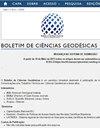STRATEGY FOR EXTRACTION OF FOURSQUARE’S SOCIAL MEDIA GEOGRAPHIC INFORMATION THROUGH DATA MINING
IF 0.5
Q3 Earth and Planetary Sciences
引用次数: 1
Abstract
Abstract This aim of this paper is the acquisition of geographic data from the Foursquare application, using data mining to perform exploratory and spatial analyses of the distribution of tourist attraction and their density distribution in Rio de Janeiro city. Thus, in accordance with the Extraction, Transformation, and Load methodology, three research algorithms were developed using a tree hierarchical structure to collect information for the categories of Museums, Monuments and Landmarks, Historic Sites, Scenic Lookouts, and Trails, in the foursquare database. Quantitative analysis was performed of check-ins per neighborhood of Rio de Janeiro city, and kernel density (hot spot) maps were generated The results presented in this paper show the need for the data filtering process - less than 50% of the mined data were used, and a large part of the density of the Museums, Historic Sites, and Monuments and Landmarks categories is in the center of the city; while the Scenic Lookouts and Trails categories predominate in the south zone. This kind of analysis was shown to be a tool to support the city's tourist management in relation to the spatial localization of these categories, the tourists’ evaluations of the places, and the frequency of the target public.通过数据挖掘提取foursquare社交媒体地理信息的策略
本文的目的是从Foursquare应用程序中获取地理数据,利用数据挖掘对巴西里约热内卢市旅游景点的分布及其密度分布进行探索性和空间分析。因此,根据提取、转换和加载方法,我们开发了三种研究算法,使用树状层次结构来收集foursquare数据库中博物馆、纪念碑和地标、历史遗址、景点瞭望和小径等类别的信息。对巴西里约热内卢市每个街区的签到情况进行了定量分析,并生成了核密度(热点)地图。本文的结果表明,需要进行数据过滤过程——挖掘数据的使用率不到50%,而且博物馆、历史遗址、纪念碑和地标类的很大一部分密度位于城市中心;而观景台和步道类别在南部地区占主导地位。这种分析可以作为支持城市旅游管理的工具,涉及到这些类别的空间定位、游客对地点的评价以及目标公众的频率。
本文章由计算机程序翻译,如有差异,请以英文原文为准。
求助全文
约1分钟内获得全文
求助全文
来源期刊

Boletim De Ciencias Geodesicas
Earth and Planetary Sciences-General Earth and Planetary Sciences
CiteScore
1.70
自引率
20.00%
发文量
10
审稿时长
3 months
期刊介绍:
The Boletim de Ciências Geodésicas publishes original papers in the area of Geodetic Sciences and correlated ones (Geodesy, Photogrammetry and Remote Sensing, Cartography and Geographic Information Systems).
Submitted articles must be unpublished, and should not be under consideration for publication in any other journal. Previous publication of the paper in conference proceedings would not violate the originality requirements. Articles must be written preferably in English language.
 求助内容:
求助内容: 应助结果提醒方式:
应助结果提醒方式:


